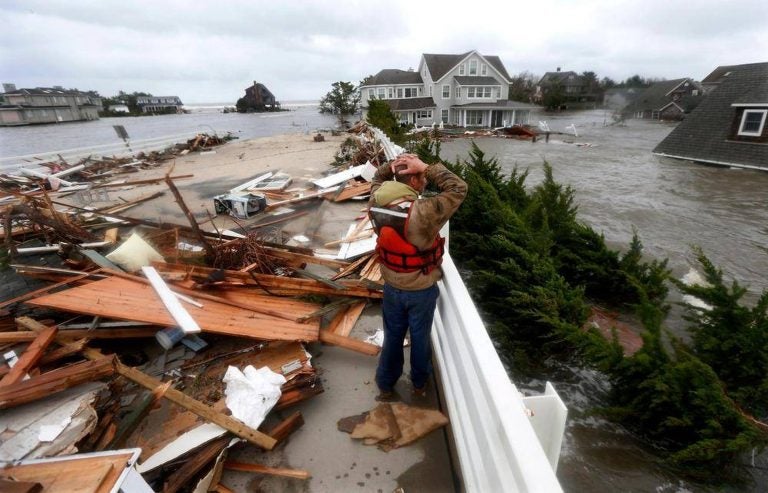Study: N.J. receives poor grade for coastal planning against climate change
New Jersey has received a poor grade for its preparation efforts to combat climate change, according to the Surfrider Foundation.

Brian Hajeski, 41, of Brick, N.J., reacts as he looks at debris of a home that washed up on to the Mantoloking Bridge the morning after superstorm Sandy rolled through in Mantoloking, N.J., Oct. 30, 2012. (Julio Cortez/AP Photo)
For the second consecutive year, New Jersey has received a poor grade for its preparation efforts to combat climate change, according to a study by an international nonprofit environmental advocacy organization.
The Surfrider Foundation’s 2019 State of the Beach Report Card has given the state a D- grade for being inadequately prepared to handle climate change impacts.
While it’s a slight improvement from last year’s failing grade, the score is much lower than nearly states: Delaware (C), Maryland (B), New York (C).
The report finds that New Jersey’s lack of strong coastal policies and planning will continue to make the state vulnerable to climate change, sea level rise, and extreme weather events.
The state received a “bad” rating for sediment management, coastal armoring, and development but a “good” mark for sea level rise management as the state has recently made progress on climate change planning, the report says.
“While New Jersey doesn’t have a statewide sea level rise policy, the state has conducted vulnerability assessments and produced resources for local communities to evaluate their vulnerability,” according to the study.
Still, the researchers say coastal residents are at risk, citing a 2019 Zillow and Climate Central report which founds that New Jersey “is developing nearly three times faster in flood zones in comparison to safer areas.”
Among the numerous recommendations, the report says the state should reduce the reliance on sand replenishment, utilize other methods of beach preservation, improve rebuilding standards after storms, prohibit new development in known hazard areas, establish managed retreat policies, and develop sea level rise adaptation plans.
New Jersey began working on a Coastal Resilience Plan in October 2018 to protect a regional backbone in addressing climate change and extreme weather impacts instead of more isolated, localized efforts.
The plan seeks to reduce risks from flooding, improve awareness and understanding, create consistent guidance, and make adaption easier.
The state held a summit at Monmouth University last year that brought together officials, environmental leaders, and coastal experts to begin the planning process.
WHYY is your source for fact-based, in-depth journalism and information. As a nonprofit organization, we rely on financial support from readers like you. Please give today.



